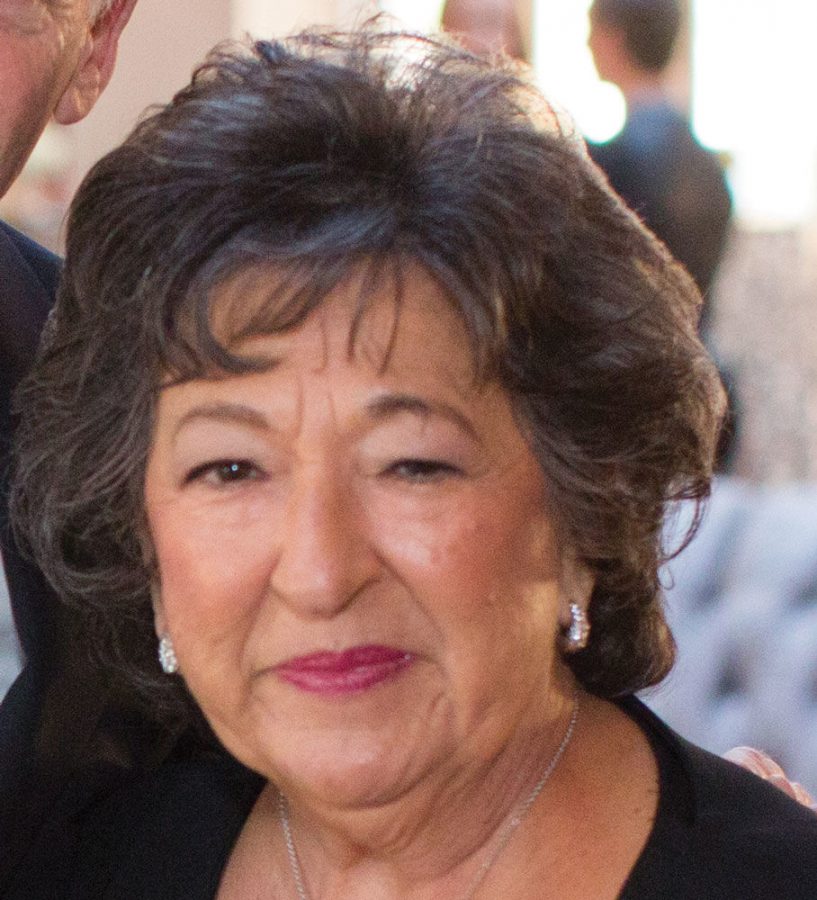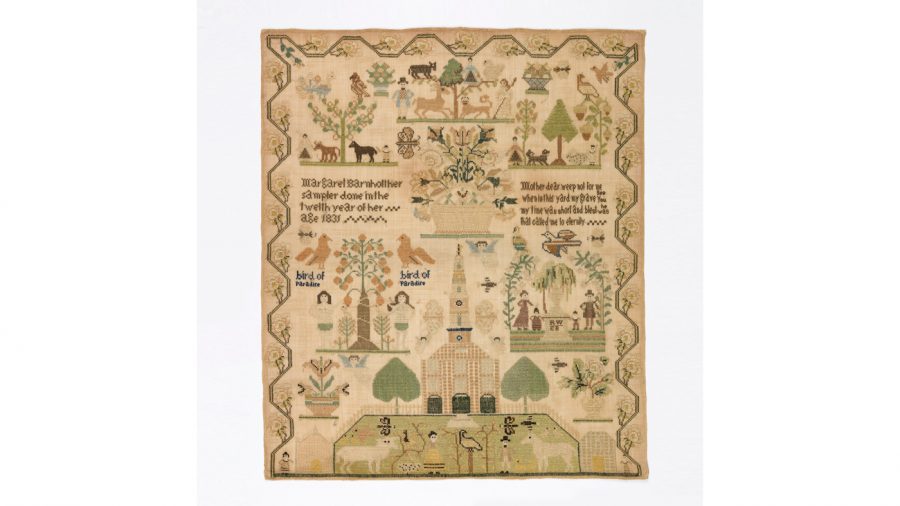Folk art: Of, by and for the people
Sampler (USA), 1831, by an unknown artist. A sampler with six scenes: a church with a garden, figures, animals, birds and butterflies in front; the garden of Eden with Adam and Eve; and a mourning scene with a weeping willow, and funerary urn, and four figures, two adults and two children. Three additional scenes show figures with animals and trees. With a rose vine border. The verse reads: Mother dear weep not for me When to this yard my grave you see my time was short and blest was he that called me to eternity From the collection of the Cooper Hewitt, Smithsonian Design Museum
Published May 10, 2021
I seem to have bit off more than I could chew when I decided to write about folk art. The subject is enormous with very blurry lines between art disciplines and even within itself.
Folk art is made by artists who have not had traditional art school backgrounds and by those who might not have had much formal education at all. Folk art is not considered fine art such as the works you would expect to see at a fine art museum and yet there are museums that house nothing but folk art. Two major folk art museums in the United States are the American Folk Art Museum in New York City and the Museum of International Folk Art in Santa Fe. The museum in New Mexico describes folk art as art that:
• May be decorative or utilitarian
• May be used every day or reserved for high ceremonies
• Is handmade; may include handmade elements as well as new, synthetic or recycled components.
• May be used for use within a community of practice or it may be produced for sale as a form of income or empowerment
• May be learned formally or informally
• May be self-taught
• May include tangible forms of expressive culture like dance, song, poetry and foodways
• Is traditional; it reflects shared cultural aesthetics and social issues
• It is recognized that as traditions are dynamic, traditional folk art may change over time and may include innovations in tradition
• Is of, by and for the people; all people, inclusive of class, status, culture, community, ethnicity, gender and religion

There are folk art museums all over the world, both large and small and many dedicated to the art of the region or a specific culture such as the Appalachian Folk Art Museum and a museum that features Norwegian Art of America.
Folk artworks, styles and motifs have inspired various artists. For example, Pablo Picasso was inspired by African tribal sculptures and masks. In 1951, the artist, writer and curator Barbara Jones organized the exhibition “Black Eyes and Lemonade” at the Whitechapel Gallery in London as part of the Festival of Britain. This exhibition, along with her publication, “The Unsophisticated Arts,” exhibited folk and mass-produced consumer objects alongside contemporary art in an early instance of the popularization of pop art in Britain.
And fine art museums such as our own St. Louis Art Museum have featured folk art exhibitions within its own walls. A few years ago, Melissa Wolfe, the in-house curator for the touring American Folk Art Exhibition, “Self-Taught Genius: Treasure from the American Folk Art Museum” wowed the public with this beautifully installed exhibition. And just a couple of months ago, Amy Tolbert, Andrew W. Mellon Foundation, Assistant Curator of American Art gave a talk entitled, “Women at Work: New Discoveries in American Folk Art.”
There are collectors of all types of folk art. One collector was Alexander Girard and his wife, who were widely known in the field of American Textile Design. The Palm Springs Art Museum had a major exhibition of Girard’s work and featured parts of his folk art collection, which is mostly housed at the Girard Foundation. One of the artists Girard supported was Cochiti Puebl pottery, Helen Cordero, the creator of storyteller pottery figurines.
Auction houses such as Christies are known to sell folk art pieces for huge sums of money and galleries all over the country sell folk art of all kinds. Laurie Ahner of Galerie Bonheur, an international folk art gallery here in St. Louis with other locations in Florida and North Carolina, says, “I find the general feeling of folk art refreshing, expressive and spiritual. It speaks from the heart and soul and cheers me every day of my life. Folk art expresses the world as the everyday man sees it, conveys the joy found in nature and the beauty of the world G-D created. Folk art is full of such earnest feelings of faith and peace which have become hard to come by in our fast paced and materialistic culture.”
Folk art goes way back in history and there are folk art societies that focus on contemporary works. In 1987, a group of 15 folk art enthusiasts met in Richmond, Va., for the purpose of forming a loosely knit club. The group went from a small, local organization to one of national stature. The name Folk Art Society of America, was chosen during the initial meeting to eliminate the idea that the art would be limited to American art. The mission of the organization is: “To advocate the discovery, study, documentation, preservation and exhibition of folk art, folk artists and folk art environments, with an emphasis on the contemporary.”
Then there is the issue of where folk art begins and ends. Some might include indigenous art under the heading of folk art and there’s outsider art and naive art in which the artists have little or no contact with the mainstream art world. Often outsider art illustrates extreme mental states, unconventional ideas and even fantasy worlds. All of these categories stem from the folk art tradition of being self-taught—usually.
And then along comes Eric Lutz, associate curator of prints, drawings and photographs at the St. Louis Art Museum, who recently curated an exhibition of photographs by anonymous photographers entitled “Poetics of the Everyday: Amateur Photography-1890-1970.” I thought this is off the beaten track, but I’d class the work as a sort of folk art.
The lines become even fuzzier.
















